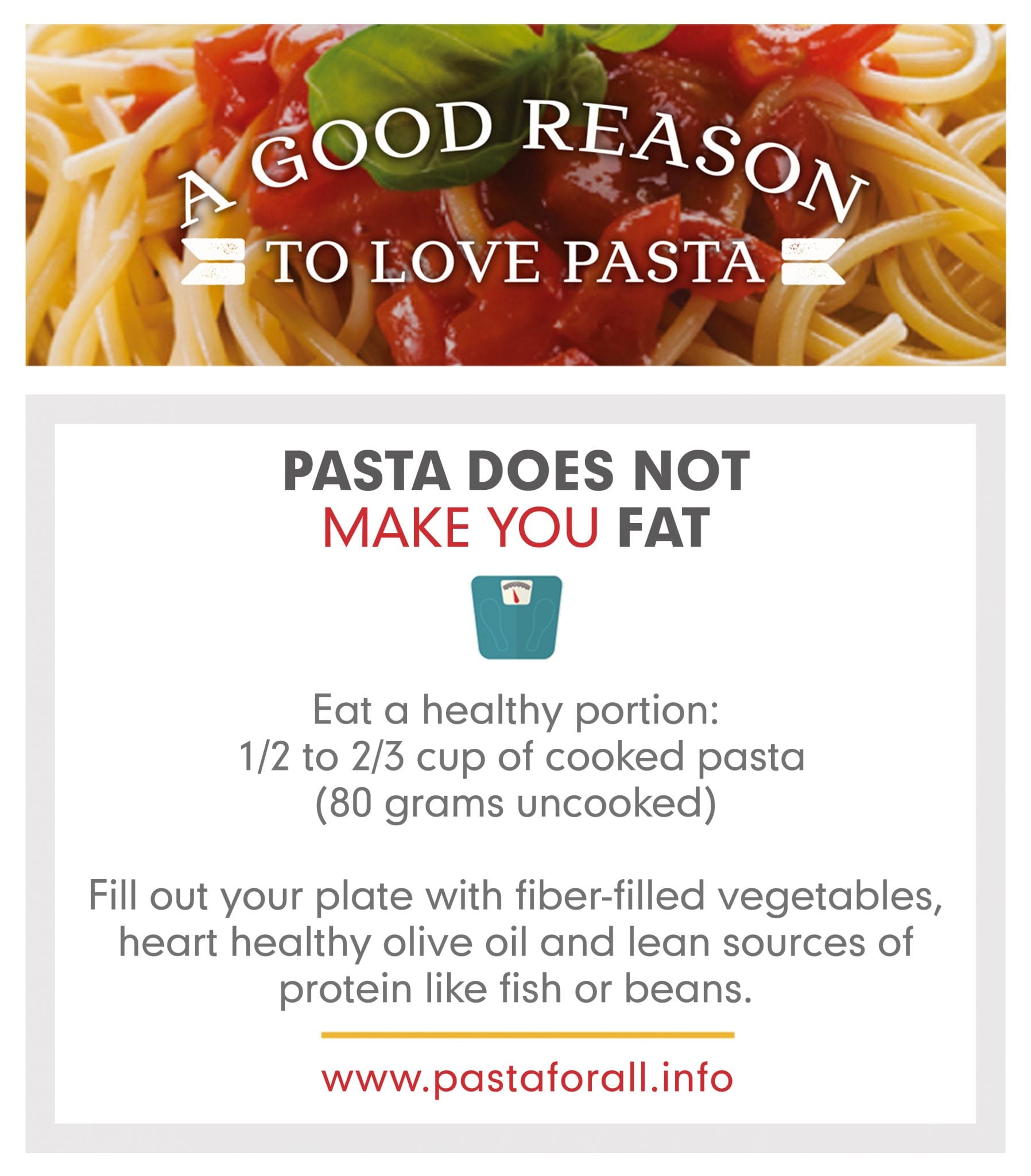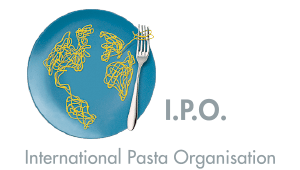- The gorgeous international film star Sophia Loren once famously said, “Everything you see I owe to spaghetti.” Without a doubt, pasta can fit with any healthy lifestyle.
- Made from durum wheat semolina or from the flour of other grains mixed with water and/or eggs, pasta is nutritious by itself. Mixed with other healthful foods like olive oil, tomato sauce, vegetables, beans, seafood and lean meats it is a key ingredient of healthy traditional eating plans around the world.
- Pasta is a carbohydrate and carbohydrates are a necessary part of a healthy diet. There is broad worldwide consensus among high-level nutrition scientists and related experts that 45-60% of our daily calories should come from healthy carbohydrates like pasta.[1]
- The best approach to eating includes all three macronutrient groups (carbohydrates, fats and protein) with an emphasis on quality choices in all three categories.[2]
- According to Marta Garaulet Aza, Ph.D., of the University of Murcia in Spain, and an expert on nutrition and weight loss, “Everything that you eat in a high amount makes you fat…even fruit. So it is a matter of the amount of food eaten. Pasta has been blamed to be [a cause of] obesity and this is not correct. We can lose weight during a weight loss treatment while eating pasta. It is not a problem, we only have to eat the right amount of pasta and we must combine it with low calorie ingredients.”
- At the 2016 World Pasta Day Conference in Moscow, nutritionist Elena Tikhomirova, discussed pasta’s benefits and said, “If you want to be slim and healthy, remember – pasta is a main course, not a side dish.”
- While low carbohydrate diets are the latest fad diet to gain popularity, experts say that reducing or eliminating this essential nutrient does not come without risks. Dr. Andrea Poli, of the Nutrition Foundation of Italy, explains that “While low carbohydrate, high protein diets often work in body weight reduction, they can be associated with health risks like higher abdominal adiposity and an increase in cardiovascular disease. In contrast, good carbohydrate diets like the Mediterranean Diet, which includes carbohydrates like pasta, vegetables and legumes, and is one of the healthiest diets in the world.”
- A new study shows that, contrary to what many think, pasta consumption is not associated with weight gain. In fact, it shows quite the opposite: The recent study [4], published in Nutrition & Diabetes, links pasta intake with significantly lower body mass indexes (BMIs) and central obesity. It also showed regular pasta consumption was associated with better adhesion to a Mediterranean-style Diet (foods such as tomatoes, onions, garlic, olive oil, and seasoned cheese) than less regular consumption of pasta.
- Healthy pasta meals are characterized by what you pair them with, as pasta can be an ideal canvas for a number of healthy ingredients. After analyzing how different pasta meals relate to diet quality, scientists, in a new study in The FASEB Journal, found that healthy pasta meals were linked with higher fiber intake and better diet quality.[5]
- As the rates of obesity and diabetes are rising around the world, pasta meals and other low-glycemic foods may help control blood sugar and weight, especially in overweight people[6].
- A Canadian Community Health Survey concluded that consuming a low-carbohydrate diet (less than 47% carbs) is associated with a greater likelihood of being obese.[7]
- While 1 in 100 people suffer from celiac disease, fully 1 in 10 now say they ‘avoid gluten.’ While sufferers of celiac disease, non-celiac gluten sensitivity or a severe wheat allergy need to avoid the gluten found in wheat-based foods like pasta, there is no evidence to show that removing gluten from the diet leads to weight loss or any health benefit for those without a medical need to avoid it.[8]
- Dr. Luca Piretta, MD, of the University Campus, Biomedico of Rome, points out that gluten-free diets are often fat-rich. While those suffering from celiac disease must follow a gluten-free diet there is no evidence that this diet is useful to other patients, obese or healthy people. [9]
- The bottom line is a healthy pasta meal features two key factors[10]:
- What You Pair with Your Pasta: Pasta is an ideal partner for healthy foods and ingredients such as vegetables, beans, and herbs (whole or in sauce form) and extra virgin olive oil. Nuts, fish, and small amounts of meat or cheese can also be added for extra flavor and protein.
- How Much Pasta You Eat in a Meal: According to most dietitians, a healthy serving of pasta for an adult is one-half to two-thirds cup of cooked pasta (80 grams of uncooked pasta), which is much less than most people are used to seeing on their plates and in restaurants. Fill out your plate with extra vegetables and lean sources of protein such as fish or beans.
Back to 5 Good Reasons to Love Pasta
[1] V World Pasta Congress, Milan, Italy, Oct. 25-27, 2015; Dr. Luca Piretta, “The Perils of Spreading Misinformation”
[2]http://wholegrainscouncil.org/files/2014wgcBBconf_BarriersMyths.pdf p. p. 7
[3]http://wholegrainscouncil.org/files/2014wgcBBconf_BarriersMyths.pdf. P.7
[4] Nutrition & Diabetes. 2016 July 4;6:e218. (G Pounis et al.)
[5]The FASEB Journal. 2016 Apr;30(1): suppl Ib332. (Fulgoni VL et al.)
[6]http://www.internationalpasta.org/resources/WPD2014/25_10_2014_WPD_2014_Buenos_Aires_Pasta_Alimento_Saludable_Sergio_Britos%281%29.pdf . Page 6
[7] Journal of the American Dietetic Association, July 2009; 109(7): 1165-72
[8]http://www.slideshare.net/FoodInsight/gluten-infographic
[9]V World Pasta Congress, Oct. 25-27, 2015, Milan; Dr. Luca Piretta “The Perils of Spreading Misinformation”
[10]http://oldwayspt.org/resources/good-food/pasta







Hello !
Thanks for the shoutout! We would welcome National Wheat Foundation in our international working group dedicated to spread The Truth About Pasta.
Would any of your team be interested in joining our next conference call meeting, scheduled on May 13, please contact me by email at f.ronca@internationalpasta.org